Home / Why Are Endo vs Exo Products Favored in the Diels-Alder Reaction?
Dienes and MO Theory
Why Are Endo vs Exo Products Favored in the Diels-Alder Reaction?
Last updated: February 17th, 2023 |
[Advanced] Secondary Orbital Interactions – A Rationale For Why Endo Products Are Favored In The Diels-Alder Reaction
In our last post, we noted that endo products tend to be favored over exo products in the Diels-Alder reaction. [We also introduced a quick-and-dirty rule for telling the difference between endo- and exo- products in the Diels-Alder.]
So why are endo products generally favored over exo in the Diels-Alder reaction? That’s what we’re going to learn about today…
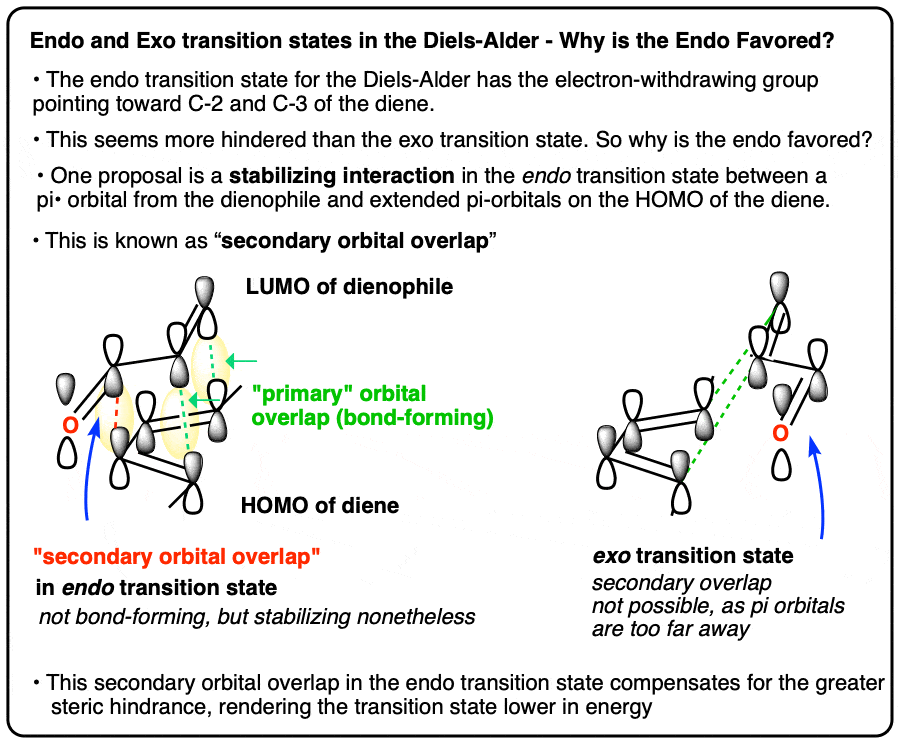
Table of Contents
- Endo Products Tend To Be Favored In The Diels-Alder Even Though They Are More Sterically Hindered
- The Endo And Exo Transition States For The Diels-Alder Reaction Between Cyclopentadiene And Maleic Anhydride
- Another Pair Of Endo And Exo Diels-Alder Transition States Shows That The Endo Transition State Places The EWG On The Dienophile Over The Diene
- Secondary Orbital Interactions Are Possible In The Endo Transition State (But Not The Exo)
- Kinetic and Thermodynamic Control of the Diels Alder Reaction
- Notes
- (Advanced) References and Further Reading
1. Endo Products Tend To Be Favored In The Diels-Alder Even Though They Are More Sterically Hindered
The preference for endo versus exo is especially curious since the endo products appear to be more sterically hindered.
For example, here’s the Diels-Alder reaction of cyclopentadiene with maleic anhydride. The ratio of endo to exo products in this reaction is about four to one:
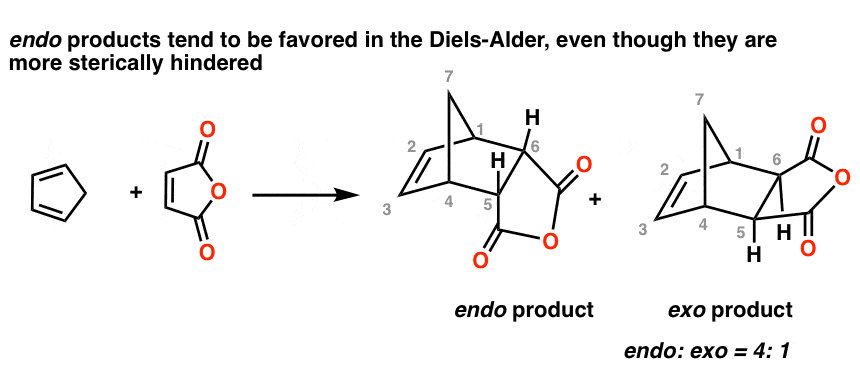
Note that in the endo product above, the anhydride is on the underside of the new six-membered ring, whereas in the exo, it points away. This is indeed less sterically hindered.
[To jump ahead, here’s a fact we’ll cover in more detail in the next post: most exo products are in fact more stable than the endo products for steric reasons, but the endo product tends to be formed faster. Furthermore, given enough heat, the Diels-Alder product can revert back to starting materials . Long story short: the Diels-Alder is another example of a reaction that can be run under kinetic or thermodynamic control, where the “endo” is the kinetic product and the “exo” is the thermodynamic product. ]
2. The Endo And Exo Transition States For The Diels-Alder Reaction Between Cyclopentadiene And Maleic Anhydride
So why is the endo typically favored?
Here’s one attempt at an explanation, using “secondary orbital effects” [Note 1]. Another related explanation is in the footnotes. [Note 2].
Our last post showed the mechanism of the Diels-Alder reaction through the orbital interactions of the highest occupied molecular orbital (HOMO) of the diene and the lowest unoccupied molecular orbital (LUMO) of the dienophile.
When the orbital interactions are drawn out in the two different transition states, we see something like this.
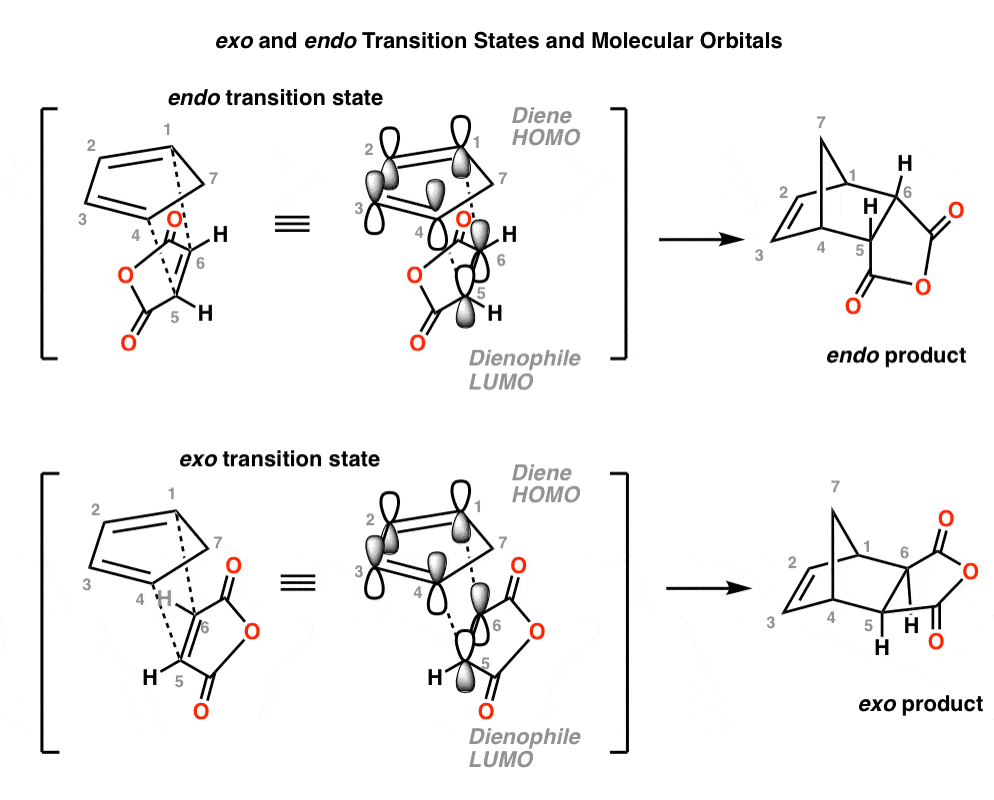
Note that in the endo transition state the electron-withdrawing groups point toward the two carbons that will eventually comprise the C2-C3 alkene, whereas in the exo transition state, the electron-withdrawing groups point away from the C2-C3 alkene:
3. Another Pair Of Endo And Exo Diels-Alder Transition States Shows That The Endo Transition State Places The EWG On The Dienophile Over The Diene
Here’s another example with (E,E)-2,4-hexadiene and acrolein. Again, note how the endo transition state has the electron withdrawing group positioned over the diene:
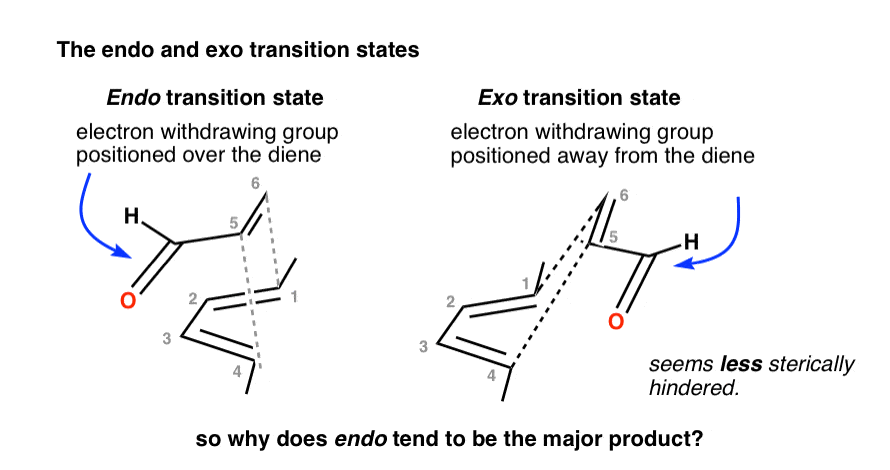
- In the endo transition state, the carbons which become the C2–C3 double bond are positioned right below the carbonyl carbon of the dienophile.
- In the exo transition state, the electron-withdrawing group points away from the C2–C3 carbons.
4. Secondary Orbital Interactions Are Possible In The Endo Transition State (But Not The Exo)
So what?
By itself, this doesn’t seem to offer any explanation as to why the endo transition state might be favored.
IF we just confine ourselves to examining the “primary” molecular orbitals – i.e. the molecular orbitals involved in bond formation.
The key difference comes when we extend our view and look the “secondary” molecular orbitals of the diene and dienophile that are not directly involved in bond formation, but might still interact with each other.
In this view, there is something special about the endo transition state that isn’t present in the exo.
Because the C2-C3 orbitals of the diene HOMO are positioned close to the C=O orbitals of the dienophile LUMO, they can interact. This isn’t possible in the exo transition state.
This is not a bond-forming interaction (that would be a “primary orbital interaction”), but it is a stabilizing interaction nonetheless. We call it a “secondary orbital interaction”. [We haven’t written about “hyperconjugation” here, but you can think of the interaction as being similar. Essentially, it’s an interaction between an occupied orbital with an unoccupied orbital to form what you can think of as a very weak “partial bond”, and the overall interaction is stabilizing].
This interaction stabilizes the endo transition state to an extent that compensates for the slightly greater steric hindrance.
Here’s what these orbitals look like:
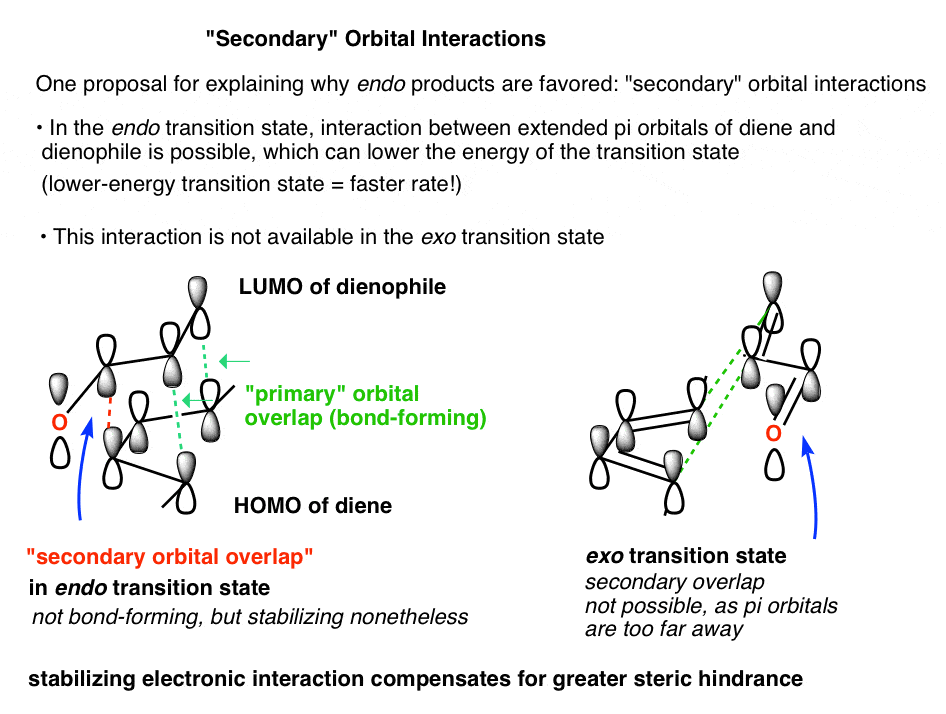
That’s really it. If you know how to draw the complete HOMO of the diene and the complete LUMO of the dienophile, then you can sketch out how they might interact. [We described how to draw out pi molecular orbitals in this post].
We’ve drawn some molecular orbitals for this reaction in the endnotes.
5. Kinetic and Thermodynamic Control of the Diels Alder Reaction
As alluded to above, the endo product tends to be the “kinetic” product, that is, the one that is formed the fastest. Under typical reaction conditions at relatively low temperature, the product distribution reflects the difference in energy between the exo and endo transition states – which is not necessarily the same thing as the difference in energy between the products!
If heated sufficiently, Diels-Alder products can revert to their starting materials, and an equilibrium between the reactants and products can be established. Under these conditions, the product distribution will reflect the difference in energy between the exo and endo products (which tends to favor the exo. )
We’ll go into more detail on the reversibility of the Diels-Alder (and kinetic vs. thermodynamic control) in a future post.
Next Post: Kinetic And Thermodynamic Control In The Diels-Alder Reaction
Notes
Related Articles
- Exo vs Endo Products In The Diels Alder: How To Tell Them Apart
- HOMO and LUMO In the Diels Alder Reaction
- Diels-Alder Reaction: Kinetic and Thermodynamic Control
- Pi Molecular Orbitals of Butadiene
- Molecular Orbitals of The Allyl Cation, Allyl Radical, and Allyl Anion
- Types of Isomers: Constitutional Isomers, Stereoisomers, Enantiomers, and Diastereomers
- Enantiomers vs Diastereomers vs The Same? Two Methods For Solving Problems
In fairness, there is some debate as to whether secondary orbital effects actually exist.
Note 1. Molecular Orbital Diagram for Secondary Orbital Interactions
Here’s another way to look at the preference for endo over exo, which incorporates the same type of interaction. The secondary orbital interaction is marked with a red dashed line, below left.
In the endo transition state, we can have a donation of electron density from electrons in the HOMO of the diene to the empty C=O pi* orbital in the LUMO of the dienophile. This isn’t possible in the exo transition state.
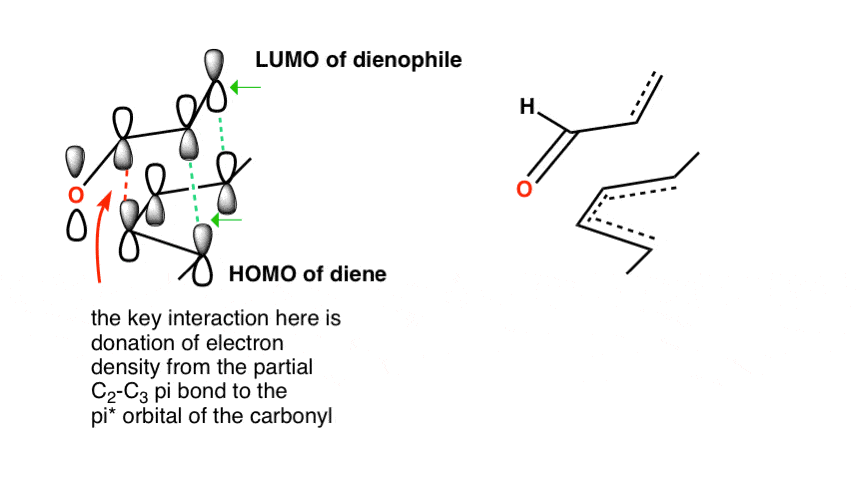
From a molecular orbital perspective, we can draw a pair of electrons in the diene HOMO on the left, and the C=O LUMO on the right.
Any time there is donation from an occupied orbital to an unoccupied orbital there is a lowering of energy.
If the two orbitals in the transition state interact, we can imagine a slight lowering of energy of the electrons (along with a corresponding raise in the energy of the LUMO).
This slight lowering of energy is responsible for the slight preference for the endo transition state.
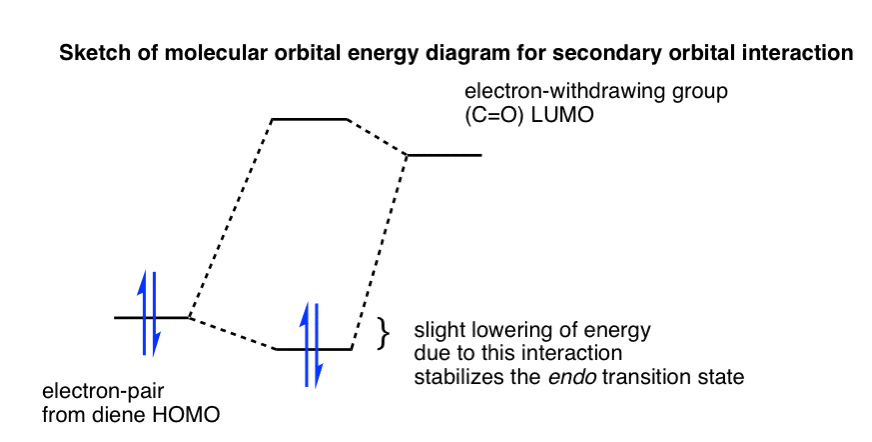
Lewis Acid Catalysis Increases endo : exo Selectivity
Here’s an extension of the same idea. It’s known that Lewis acids (such as ZnCl2, TiCl4, SnCl4, and many others) can accelerate the rate of Diels-Alder reactions. It can also increase the endo : exo selectivity!
For instance, compare the rate of non-Lewis acid catalyzed versus Lewis-acid catalyzed ratios in this reaction. [Reference]
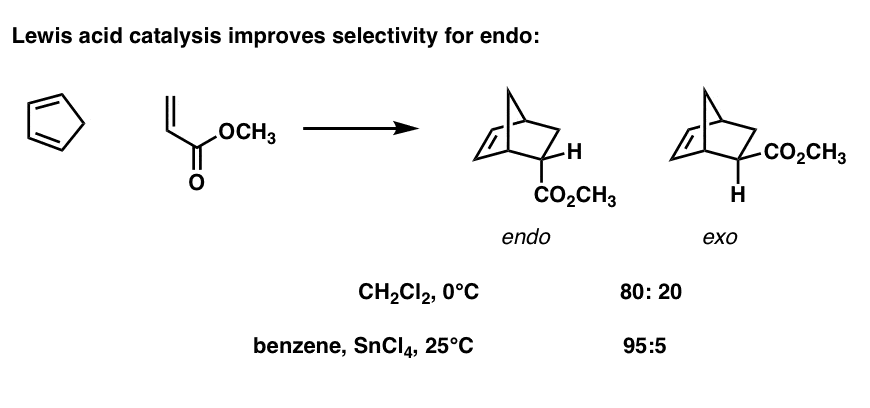
What happens is that the LUMO of the C=O bond is lowered when a Lewis acid coordinates to the carbonyl.
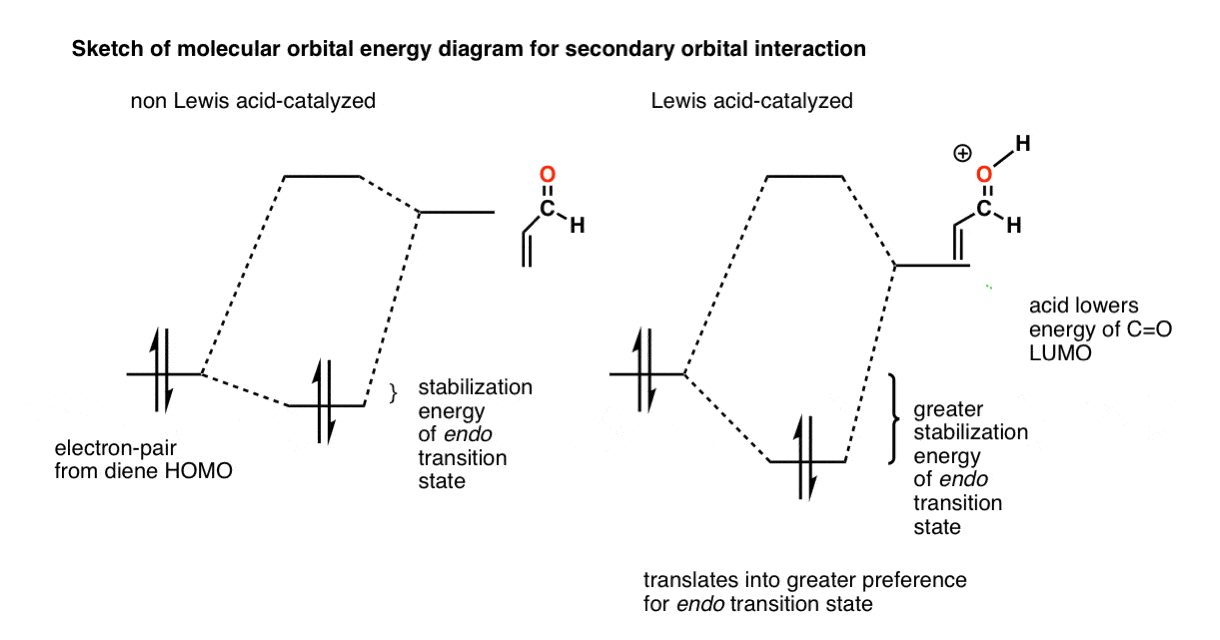
For reasons we won’t explain, the interaction between orbitals strengthens as they become closer together in energy. Therefore the secondary orbital interaction is strengthened and a greater stabilization energy is obtained for the endo transition state.
That’s probably too much for this site, but there you go.
For more information, I highly suggest hunting down Dave Evans’ Chemistry 206 notes from Harvard, if you can find them. They are excellent.
(Advanced) References and Further Reading
An important stereochemical feature of the Diels-Alder reaction is addressed by the Alder Endo Rule. This is based on empirical observations that if two isomeric products are possible, the one that has an unsaturated substituent(s) on the alkene oriented toward the newly formed cyclohexene double bond is the preferred product. The two alternative transition states are referred to as the endo and exo transition states.
- Untersuchungen über den Verlauf der Diensynthese
Kurt Alder, Gerhard Stein
Angew. Chem. 1937, 50 (28), 510-519
DOI: 10.1002/ange.19370502804
First paper by Alder describing what is now known as the Alder Endo Rule. After a “sandwich-like” preorientation of the reactants, the dienophile is added in such a way as to give a “maximum concentration” of double bonds in the transition state; according to Alder and Stein this includes not only the p systems directly involved in the reaction, but also those of the “activating ligands”. - ACCELERATION OF THE DIELS-ALDER REACTION BY ALUMINUM CHLORIDE
Peter Yates and Philip Eaton
Journal of the American Chemical Society 1960 82 (16), 4436-4437
DOI: 10.1021/ja01501a085 - Lewis acid catalysis of Diels-Alder reactions
K. N. Houk and R. W. Strozier
Journal of the American Chemical Society 1973, 95 (12), 4094-4096
DOI: 10.1021/ja00793a070 - Transition structures of the Lewis acid-catalyzed Diels-Alder reaction of butadiene with acrolein. The origins of selectivity
David M. Birney and K. N. Houk
Journal of the American Chemical Society 1990, 112 (11), 4127-4133
DOI: 10.1021/ja00167a005
Lewis acid complexation accentuates both the energy and orbital distortion effects of substitution on the dienophile, and enhanced both the reactivity and selectivity of the dienophile relative to the uncomplexed compound. The effects are well-modeled by computational studies on the transition-state structures. Prof. K. N. Houk (now at UCLA) is very well-regarded today for his work in computational chemistry. - Do Secondary Orbital Interactions Really Exist?
José I. García, José A. Mayoral, and Luis Salvatella
Accounts of Chemical Research 2000, 33 (10), 658-664
DOI: 10.1021/ar0000152 - The Source of the endo Rule in the Diels−Alder Reaction: Are Secondary Orbital Interactions Really Necessary?
José Ignacio García, José Antonio Mayoral, and Luis Salvatella
J. Org. Chem. 2005, 1, 85-90
DOI: 10.1002/ejoc.200400424
One of the proposed explanations for the Alder Endo Rule is secondary orbital interactions, and there is debate as to whether these actually exist or not. - Diels‐Alder reactions II: The Reaction Mechanism
Dr. J. Sauer
Angew. Chem. Int. Ed. 1967, 6 (1), 16-33
DOI: 10.1002/anie.196700161
Even though this review might be over 50 years old, it still contains very useful information, such as the influence of Lewis Acids on endo:exo selectivity. - Endo and Exo transition states in the Diels-Alder reaction
William C. Herndon and Lowell H. Hall
Tetrahedron Lett. 1967, 8 (32), 3095-3100
DOI: 10.1016/S0040-4039(00)90922-5
An very early theoretical study on Diels-Alder transition states, providing geometric arguments for the Alder Endo Rule. - Looking beyond the endo Rule in a Diels-Alder Discovery Lab
Ronald M. Jarret, Jamie New, Rebecca Hurley, and Laura Gillooly
Journal of Chemical Education 2001, 78 (9), 1262
DOI: 10.1021/ed078p1262
This paper from the Journal of Chemical Education shows how the Alder Endo Rule can be observed in a simple Diels-Alder reaction carried out by undergraduates. - The First General Enantioselective Catalytic Diels−Alder Reaction with Simple α,β-Unsaturated Ketones
Alan B. Northrup and and David W. C. MacMillan
Journal of the American Chemical Society 2002 124 (11), 2458-2460
DOI: 10.1021/ja017641u
In this paper, D. W. C. MacMillan’s research group investigated cycloadditions between ethyl vinyl ketone, EtCOCH=CH2, and several simple dienes. As a rule, endo selectivity was not very high. They reasoned that making the dienophile more electron-poor should improve selectivity (and reaction rate, and yield) and this might be achieved by converting the carbonyl group, C=O, into an iminium ion, C=NR2+. They also reasoned that it should be possible to produce the iminium ion catalytically by combining the ketone with a small amount of acid and a small amount of a chiral amine. This area is now known as organocatalysis, and a tremendous amount of work now being done in this area. - The Diels Alder Reaction
The late Hans Reich (U. Wisconsin-Madison) has a website full of useful information on organic chemistry, including this page on the Diels-Alder reaction.
00 General Chemistry Review
01 Bonding, Structure, and Resonance
- How Do We Know Methane (CH4) Is Tetrahedral?
- Hybrid Orbitals and Hybridization
- How To Determine Hybridization: A Shortcut
- Orbital Hybridization And Bond Strengths
- Sigma bonds come in six varieties: Pi bonds come in one
- A Key Skill: How to Calculate Formal Charge
- The Four Intermolecular Forces and How They Affect Boiling Points
- 3 Trends That Affect Boiling Points
- How To Use Electronegativity To Determine Electron Density (and why NOT to trust formal charge)
- Introduction to Resonance
- How To Use Curved Arrows To Interchange Resonance Forms
- Evaluating Resonance Forms (1) - The Rule of Least Charges
- How To Find The Best Resonance Structure By Applying Electronegativity
- Evaluating Resonance Structures With Negative Charges
- Evaluating Resonance Structures With Positive Charge
- Exploring Resonance: Pi-Donation
- Exploring Resonance: Pi-acceptors
- In Summary: Evaluating Resonance Structures
- Drawing Resonance Structures: 3 Common Mistakes To Avoid
- How to apply electronegativity and resonance to understand reactivity
- Bond Hybridization Practice
- Structure and Bonding Practice Quizzes
- Resonance Structures Practice
02 Acid Base Reactions
- Introduction to Acid-Base Reactions
- Acid Base Reactions In Organic Chemistry
- The Stronger The Acid, The Weaker The Conjugate Base
- Walkthrough of Acid-Base Reactions (3) - Acidity Trends
- Five Key Factors That Influence Acidity
- Acid-Base Reactions: Introducing Ka and pKa
- How to Use a pKa Table
- The pKa Table Is Your Friend
- A Handy Rule of Thumb for Acid-Base Reactions
- Acid Base Reactions Are Fast
- pKa Values Span 60 Orders Of Magnitude
- How Protonation and Deprotonation Affect Reactivity
- Acid Base Practice Problems
03 Alkanes and Nomenclature
- Meet the (Most Important) Functional Groups
- Condensed Formulas: Deciphering What the Brackets Mean
- Hidden Hydrogens, Hidden Lone Pairs, Hidden Counterions
- Don't Be Futyl, Learn The Butyls
- Primary, Secondary, Tertiary, Quaternary In Organic Chemistry
- Branching, and Its Affect On Melting and Boiling Points
- The Many, Many Ways of Drawing Butane
- Wedge And Dash Convention For Tetrahedral Carbon
- Common Mistakes in Organic Chemistry: Pentavalent Carbon
- Table of Functional Group Priorities for Nomenclature
- Summary Sheet - Alkane Nomenclature
- Organic Chemistry IUPAC Nomenclature Demystified With A Simple Puzzle Piece Approach
- Boiling Point Quizzes
- Organic Chemistry Nomenclature Quizzes
04 Conformations and Cycloalkanes
- Staggered vs Eclipsed Conformations of Ethane
- Conformational Isomers of Propane
- Newman Projection of Butane (and Gauche Conformation)
- Introduction to Cycloalkanes
- Geometric Isomers In Small Rings: Cis And Trans Cycloalkanes
- Calculation of Ring Strain In Cycloalkanes
- Cycloalkanes - Ring Strain In Cyclopropane And Cyclobutane
- Cyclohexane Conformations
- Cyclohexane Chair Conformation: An Aerial Tour
- How To Draw The Cyclohexane Chair Conformation
- The Cyclohexane Chair Flip
- The Cyclohexane Chair Flip - Energy Diagram
- Substituted Cyclohexanes - Axial vs Equatorial
- Ranking The Bulkiness Of Substituents On Cyclohexanes: "A-Values"
- Cyclohexane Chair Conformation Stability: Which One Is Lower Energy?
- Fused Rings - Cis-Decalin and Trans-Decalin
- Naming Bicyclic Compounds - Fused, Bridged, and Spiro
- Bredt's Rule (And Summary of Cycloalkanes)
- Newman Projection Practice
- Cycloalkanes Practice Problems
05 A Primer On Organic Reactions
- The Most Important Question To Ask When Learning a New Reaction
- Curved Arrows (for reactions)
- Nucleophiles and Electrophiles
- The Three Classes of Nucleophiles
- Nucleophilicity vs. Basicity
- What Makes A Good Nucleophile?
- What Makes A Good Leaving Group?
- 3 Factors That Stabilize Carbocations
- Equilibrium and Energy Relationships
- 7 Factors that stabilize negative charge in organic chemistry
- 7 Factors That Stabilize Positive Charge in Organic Chemistry
- What's a Transition State?
- Hammond's Postulate
- Learning Organic Chemistry Reactions: A Checklist (PDF)
- Introduction to Oxidative Cleavage Reactions
06 Free Radical Reactions
- Bond Dissociation Energies = Homolytic Cleavage
- Free Radical Reactions
- 3 Factors That Stabilize Free Radicals
- What Factors Destabilize Free Radicals?
- Bond Strengths And Radical Stability
- Free Radical Initiation: Why Is "Light" Or "Heat" Required?
- Initiation, Propagation, Termination
- Monochlorination Products Of Propane, Pentane, And Other Alkanes
- Selectivity In Free Radical Reactions
- Selectivity in Free Radical Reactions: Bromination vs. Chlorination
- Halogenation At Tiffany's
- Allylic Bromination
- Bonus Topic: Allylic Rearrangements
- In Summary: Free Radicals
- Synthesis (2) - Reactions of Alkanes
- Free Radicals Practice Quizzes
07 Stereochemistry and Chirality
- Types of Isomers: Constitutional Isomers, Stereoisomers, Enantiomers, and Diastereomers
- How To Draw The Enantiomer Of A Chiral Molecule
- How To Draw A Bond Rotation
- Introduction to Assigning (R) and (S): The Cahn-Ingold-Prelog Rules
- Assigning Cahn-Ingold-Prelog (CIP) Priorities (2) - The Method of Dots
- Enantiomers vs Diastereomers vs The Same? Two Methods For Solving Problems
- Assigning R/S To Newman Projections (And Converting Newman To Line Diagrams)
- How To Determine R and S Configurations On A Fischer Projection
- The Meso Trap
- Optical Rotation, Optical Activity, and Specific Rotation
- Optical Purity and Enantiomeric Excess
- What's a Racemic Mixture?
- Chiral Allenes And Chiral Axes
- Stereochemistry Practice Problems and Quizzes
08 Substitution Reactions
- Nucleophilic Substitution Reactions - Introduction
- Two Types of Nucleophilic Substitution Reactions
- The SN2 Mechanism
- Why the SN2 Reaction Is Powerful
- The SN1 Mechanism
- The Conjugate Acid Is A Better Leaving Group
- Comparing the SN1 and SN2 Reactions
- Polar Protic? Polar Aprotic? Nonpolar? All About Solvents
- Steric Hindrance is Like a Fat Goalie
- Common Blind Spot: Intramolecular Reactions
- Substitution Practice - SN1
- Substitution Practice - SN2
09 Elimination Reactions
- Elimination Reactions (1): Introduction And The Key Pattern
- Elimination Reactions (2): The Zaitsev Rule
- Elimination Reactions Are Favored By Heat
- Two Elimination Reaction Patterns
- The E1 Reaction
- The E2 Mechanism
- E1 vs E2: Comparing the E1 and E2 Reactions
- Antiperiplanar Relationships: The E2 Reaction and Cyclohexane Rings
- Bulky Bases in Elimination Reactions
- Comparing the E1 vs SN1 Reactions
- Elimination (E1) Reactions With Rearrangements
- E1cB - Elimination (Unimolecular) Conjugate Base
- Elimination (E1) Practice Problems And Solutions
- Elimination (E2) Practice Problems and Solutions
10 Rearrangements
11 SN1/SN2/E1/E2 Decision
- Identifying Where Substitution and Elimination Reactions Happen
- Deciding SN1/SN2/E1/E2 (1) - The Substrate
- Deciding SN1/SN2/E1/E2 (2) - The Nucleophile/Base
- SN1 vs E1 and SN2 vs E2 : The Temperature
- Deciding SN1/SN2/E1/E2 - The Solvent
- Wrapup: The Key Factors For Determining SN1/SN2/E1/E2
- Alkyl Halide Reaction Map And Summary
- SN1 SN2 E1 E2 Practice Problems
12 Alkene Reactions
- E and Z Notation For Alkenes (+ Cis/Trans)
- Alkene Stability
- Alkene Addition Reactions: "Regioselectivity" and "Stereoselectivity" (Syn/Anti)
- Stereoselective and Stereospecific Reactions
- Hydrohalogenation of Alkenes and Markovnikov's Rule
- Hydration of Alkenes With Aqueous Acid
- Rearrangements in Alkene Addition Reactions
- Halogenation of Alkenes and Halohydrin Formation
- Oxymercuration Demercuration of Alkenes
- Hydroboration Oxidation of Alkenes
- m-CPBA (meta-chloroperoxybenzoic acid)
- OsO4 (Osmium Tetroxide) for Dihydroxylation of Alkenes
- Palladium on Carbon (Pd/C) for Catalytic Hydrogenation of Alkenes
- Cyclopropanation of Alkenes
- A Fourth Alkene Addition Pattern - Free Radical Addition
- Alkene Reactions: Ozonolysis
- Summary: Three Key Families Of Alkene Reaction Mechanisms
- Synthesis (4) - Alkene Reaction Map, Including Alkyl Halide Reactions
- Alkene Reactions Practice Problems
13 Alkyne Reactions
- Acetylides from Alkynes, And Substitution Reactions of Acetylides
- Partial Reduction of Alkynes With Lindlar's Catalyst
- Partial Reduction of Alkynes With Na/NH3 To Obtain Trans Alkenes
- Alkyne Hydroboration With "R2BH"
- Hydration and Oxymercuration of Alkynes
- Hydrohalogenation of Alkynes
- Alkyne Halogenation: Bromination, Chlorination, and Iodination of Alkynes
- Alkyne Reactions - The "Concerted" Pathway
- Alkenes To Alkynes Via Halogenation And Elimination Reactions
- Alkynes Are A Blank Canvas
- Synthesis (5) - Reactions of Alkynes
- Alkyne Reactions Practice Problems With Answers
14 Alcohols, Epoxides and Ethers
- Alcohols - Nomenclature and Properties
- Alcohols Can Act As Acids Or Bases (And Why It Matters)
- Alcohols - Acidity and Basicity
- The Williamson Ether Synthesis
- Ethers From Alkenes, Tertiary Alkyl Halides and Alkoxymercuration
- Alcohols To Ethers via Acid Catalysis
- Cleavage Of Ethers With Acid
- Epoxides - The Outlier Of The Ether Family
- Opening of Epoxides With Acid
- Epoxide Ring Opening With Base
- Making Alkyl Halides From Alcohols
- Tosylates And Mesylates
- PBr3 and SOCl2
- Elimination Reactions of Alcohols
- Elimination of Alcohols To Alkenes With POCl3
- Alcohol Oxidation: "Strong" and "Weak" Oxidants
- Demystifying The Mechanisms of Alcohol Oxidations
- Protecting Groups For Alcohols
- Thiols And Thioethers
- Calculating the oxidation state of a carbon
- Oxidation and Reduction in Organic Chemistry
- Oxidation Ladders
- SOCl2 Mechanism For Alcohols To Alkyl Halides: SN2 versus SNi
- Alcohol Reactions Roadmap (PDF)
- Alcohol Reaction Practice Problems
- Epoxide Reaction Quizzes
- Oxidation and Reduction Practice Quizzes
15 Organometallics
- What's An Organometallic?
- Formation of Grignard and Organolithium Reagents
- Organometallics Are Strong Bases
- Reactions of Grignard Reagents
- Protecting Groups In Grignard Reactions
- Synthesis Problems Involving Grignard Reagents
- Grignard Reactions And Synthesis (2)
- Organocuprates (Gilman Reagents): How They're Made
- Gilman Reagents (Organocuprates): What They're Used For
- The Heck, Suzuki, and Olefin Metathesis Reactions (And Why They Don't Belong In Most Introductory Organic Chemistry Courses)
- Reaction Map: Reactions of Organometallics
- Grignard Practice Problems
16 Spectroscopy
- Degrees of Unsaturation (or IHD, Index of Hydrogen Deficiency)
- Conjugation And Color (+ How Bleach Works)
- Introduction To UV-Vis Spectroscopy
- UV-Vis Spectroscopy: Absorbance of Carbonyls
- UV-Vis Spectroscopy: Practice Questions
- Bond Vibrations, Infrared Spectroscopy, and the "Ball and Spring" Model
- Infrared Spectroscopy: A Quick Primer On Interpreting Spectra
- IR Spectroscopy: 4 Practice Problems
- 1H NMR: How Many Signals?
- Homotopic, Enantiotopic, Diastereotopic
- Diastereotopic Protons in 1H NMR Spectroscopy: Examples
- 13-C NMR - How Many Signals
- Liquid Gold: Pheromones In Doe Urine
- Natural Product Isolation (1) - Extraction
- Natural Product Isolation (2) - Purification Techniques, An Overview
- Structure Determination Case Study: Deer Tarsal Gland Pheromone
17 Dienes and MO Theory
- What To Expect In Organic Chemistry 2
- Are these molecules conjugated?
- Conjugation And Resonance In Organic Chemistry
- Bonding And Antibonding Pi Orbitals
- Molecular Orbitals of The Allyl Cation, Allyl Radical, and Allyl Anion
- Pi Molecular Orbitals of Butadiene
- Reactions of Dienes: 1,2 and 1,4 Addition
- Thermodynamic and Kinetic Products
- More On 1,2 and 1,4 Additions To Dienes
- s-cis and s-trans
- The Diels-Alder Reaction
- Cyclic Dienes and Dienophiles in the Diels-Alder Reaction
- Stereochemistry of the Diels-Alder Reaction
- Exo vs Endo Products In The Diels Alder: How To Tell Them Apart
- HOMO and LUMO In the Diels Alder Reaction
- Why Are Endo vs Exo Products Favored in the Diels-Alder Reaction?
- Diels-Alder Reaction: Kinetic and Thermodynamic Control
- The Retro Diels-Alder Reaction
- The Intramolecular Diels Alder Reaction
- Regiochemistry In The Diels-Alder Reaction
- The Cope and Claisen Rearrangements
- Electrocyclic Reactions
- Electrocyclic Ring Opening And Closure (2) - Six (or Eight) Pi Electrons
- Diels Alder Practice Problems
- Molecular Orbital Theory Practice
18 Aromaticity
- Introduction To Aromaticity
- Rules For Aromaticity
- Huckel's Rule: What Does 4n+2 Mean?
- Aromatic, Non-Aromatic, or Antiaromatic? Some Practice Problems
- Antiaromatic Compounds and Antiaromaticity
- The Pi Molecular Orbitals of Benzene
- The Pi Molecular Orbitals of Cyclobutadiene
- Frost Circles
- Aromaticity Practice Quizzes
19 Reactions of Aromatic Molecules
- Electrophilic Aromatic Substitution: Introduction
- Activating and Deactivating Groups In Electrophilic Aromatic Substitution
- Electrophilic Aromatic Substitution - The Mechanism
- Ortho-, Para- and Meta- Directors in Electrophilic Aromatic Substitution
- Understanding Ortho, Para, and Meta Directors
- Why are halogens ortho- para- directors?
- Disubstituted Benzenes: The Strongest Electron-Donor "Wins"
- Electrophilic Aromatic Substitutions (1) - Halogenation of Benzene
- Electrophilic Aromatic Substitutions (2) - Nitration and Sulfonation
- EAS Reactions (3) - Friedel-Crafts Acylation and Friedel-Crafts Alkylation
- Intramolecular Friedel-Crafts Reactions
- Nucleophilic Aromatic Substitution (NAS)
- Nucleophilic Aromatic Substitution (2) - The Benzyne Mechanism
- Reactions on the "Benzylic" Carbon: Bromination And Oxidation
- The Wolff-Kishner, Clemmensen, And Other Carbonyl Reductions
- More Reactions on the Aromatic Sidechain: Reduction of Nitro Groups and the Baeyer Villiger
- Aromatic Synthesis (1) - "Order Of Operations"
- Synthesis of Benzene Derivatives (2) - Polarity Reversal
- Aromatic Synthesis (3) - Sulfonyl Blocking Groups
- Birch Reduction
- Synthesis (7): Reaction Map of Benzene and Related Aromatic Compounds
- Aromatic Reactions and Synthesis Practice
- Electrophilic Aromatic Substitution Practice Problems
20 Aldehydes and Ketones
- What's The Alpha Carbon In Carbonyl Compounds?
- Nucleophilic Addition To Carbonyls
- Aldehydes and Ketones: 14 Reactions With The Same Mechanism
- Sodium Borohydride (NaBH4) Reduction of Aldehydes and Ketones
- Grignard Reagents For Addition To Aldehydes and Ketones
- Wittig Reaction
- Hydrates, Hemiacetals, and Acetals
- Imines - Properties, Formation, Reactions, and Mechanisms
- All About Enamines
- Breaking Down Carbonyl Reaction Mechanisms: Reactions of Anionic Nucleophiles (Part 2)
- Aldehydes Ketones Reaction Practice
21 Carboxylic Acid Derivatives
- Nucleophilic Acyl Substitution (With Negatively Charged Nucleophiles)
- Addition-Elimination Mechanisms With Neutral Nucleophiles (Including Acid Catalysis)
- Basic Hydrolysis of Esters - Saponification
- Transesterification
- Proton Transfer
- Fischer Esterification - Carboxylic Acid to Ester Under Acidic Conditions
- Lithium Aluminum Hydride (LiAlH4) For Reduction of Carboxylic Acid Derivatives
- LiAlH[Ot-Bu]3 For The Reduction of Acid Halides To Aldehydes
- Di-isobutyl Aluminum Hydride (DIBAL) For The Partial Reduction of Esters and Nitriles
- Amide Hydrolysis
- Thionyl Chloride (SOCl2)
- Diazomethane (CH2N2)
- Carbonyl Chemistry: Learn Six Mechanisms For the Price Of One
- Making Music With Mechanisms (PADPED)
- Carboxylic Acid Derivatives Practice Questions
22 Enols and Enolates
- Keto-Enol Tautomerism
- Enolates - Formation, Stability, and Simple Reactions
- Kinetic Versus Thermodynamic Enolates
- Aldol Addition and Condensation Reactions
- Reactions of Enols - Acid-Catalyzed Aldol, Halogenation, and Mannich Reactions
- Claisen Condensation and Dieckmann Condensation
- Decarboxylation
- The Malonic Ester and Acetoacetic Ester Synthesis
- The Michael Addition Reaction and Conjugate Addition
- The Robinson Annulation
- Haloform Reaction
- The Hell–Volhard–Zelinsky Reaction
- Enols and Enolates Practice Quizzes
23 Amines
- The Amide Functional Group: Properties, Synthesis, and Nomenclature
- Basicity of Amines And pKaH
- 5 Key Basicity Trends of Amines
- The Mesomeric Effect And Aromatic Amines
- Nucleophilicity of Amines
- Alkylation of Amines (Sucks!)
- Reductive Amination
- The Gabriel Synthesis
- Some Reactions of Azides
- The Hofmann Elimination
- The Hofmann and Curtius Rearrangements
- The Cope Elimination
- Protecting Groups for Amines - Carbamates
- The Strecker Synthesis of Amino Acids
- Introduction to Peptide Synthesis
- Reactions of Diazonium Salts: Sandmeyer and Related Reactions
- Amine Practice Questions
24 Carbohydrates
- D and L Notation For Sugars
- Pyranoses and Furanoses: Ring-Chain Tautomerism In Sugars
- What is Mutarotation?
- Reducing Sugars
- The Big Damn Post Of Carbohydrate-Related Chemistry Definitions
- The Haworth Projection
- Converting a Fischer Projection To A Haworth (And Vice Versa)
- Reactions of Sugars: Glycosylation and Protection
- The Ruff Degradation and Kiliani-Fischer Synthesis
- Isoelectric Points of Amino Acids (and How To Calculate Them)
- Carbohydrates Practice
- Amino Acid Quizzes
25 Fun and Miscellaneous
- A Gallery of Some Interesting Molecules From Nature
- Screw Organic Chemistry, I'm Just Going To Write About Cats
- On Cats, Part 1: Conformations and Configurations
- On Cats, Part 2: Cat Line Diagrams
- On Cats, Part 4: Enantiocats
- On Cats, Part 6: Stereocenters
- Organic Chemistry Is Shit
- The Organic Chemistry Behind "The Pill"
- Maybe they should call them, "Formal Wins" ?
- Why Do Organic Chemists Use Kilocalories?
- The Principle of Least Effort
- Organic Chemistry GIFS - Resonance Forms
- Reproducibility In Organic Chemistry
- What Holds The Nucleus Together?
- How Reactions Are Like Music
- Organic Chemistry and the New MCAT
26 Organic Chemistry Tips and Tricks
- Common Mistakes: Formal Charges Can Mislead
- Partial Charges Give Clues About Electron Flow
- Draw The Ugly Version First
- Organic Chemistry Study Tips: Learn the Trends
- The 8 Types of Arrows In Organic Chemistry, Explained
- Top 10 Skills To Master Before An Organic Chemistry 2 Final
- Common Mistakes with Carbonyls: Carboxylic Acids... Are Acids!
- Planning Organic Synthesis With "Reaction Maps"
- Alkene Addition Pattern #1: The "Carbocation Pathway"
- Alkene Addition Pattern #2: The "Three-Membered Ring" Pathway
- Alkene Addition Pattern #3: The "Concerted" Pathway
- Number Your Carbons!
- The 4 Major Classes of Reactions in Org 1
- How (and why) electrons flow
- Grossman's Rule
- Three Exam Tips
- A 3-Step Method For Thinking Through Synthesis Problems
- Putting It Together
- Putting Diels-Alder Products in Perspective
- The Ups and Downs of Cyclohexanes
- The Most Annoying Exceptions in Org 1 (Part 1)
- The Most Annoying Exceptions in Org 1 (Part 2)
- The Marriage May Be Bad, But the Divorce Still Costs Money
- 9 Nomenclature Conventions To Know
- Nucleophile attacks Electrophile
27 Case Studies of Successful O-Chem Students
- Success Stories: How Corina Got The The "Hard" Professor - And Got An A+ Anyway
- How Helena Aced Organic Chemistry
- From a "Drop" To B+ in Org 2 – How A Hard Working Student Turned It Around
- How Serge Aced Organic Chemistry
- Success Stories: How Zach Aced Organic Chemistry 1
- Success Stories: How Kari Went From C– to B+
- How Esther Bounced Back From a "C" To Get A's In Organic Chemistry 1 And 2
- How Tyrell Got The Highest Grade In Her Organic Chemistry Course
- This Is Why Students Use Flashcards
- Success Stories: How Stu Aced Organic Chemistry
- How John Pulled Up His Organic Chemistry Exam Grades
- Success Stories: How Nathan Aced Organic Chemistry (Without It Taking Over His Life)
- How Chris Aced Org 1 and Org 2
- Interview: How Jay Got an A+ In Organic Chemistry
- How to Do Well in Organic Chemistry: One Student's Advice
- "America's Top TA" Shares His Secrets For Teaching O-Chem
- "Organic Chemistry Is Like..." - A Few Metaphors
- How To Do Well In Organic Chemistry: Advice From A Tutor
- Guest post: "I went from being afraid of tests to actually looking forward to them".
superb!!! thank you for such helpful explanation
Very good explained and is really helpful…i must appriciateyou for publishing such beneficial addition to organic chemistry
Really it’s helpful…thank you for publishing such beneficial topics on organic chemistry
OK, thank you Pompi. Always looking for suggestions to make it better.
Absolutely brilliant!!
Thanks for putting in so much effort and helping us out.
Thanks Gaurav. Glad you find it helpful.
This is very helpful information. Not explained well by my lecturer. Thank you.
Glad this was useful Jordan!